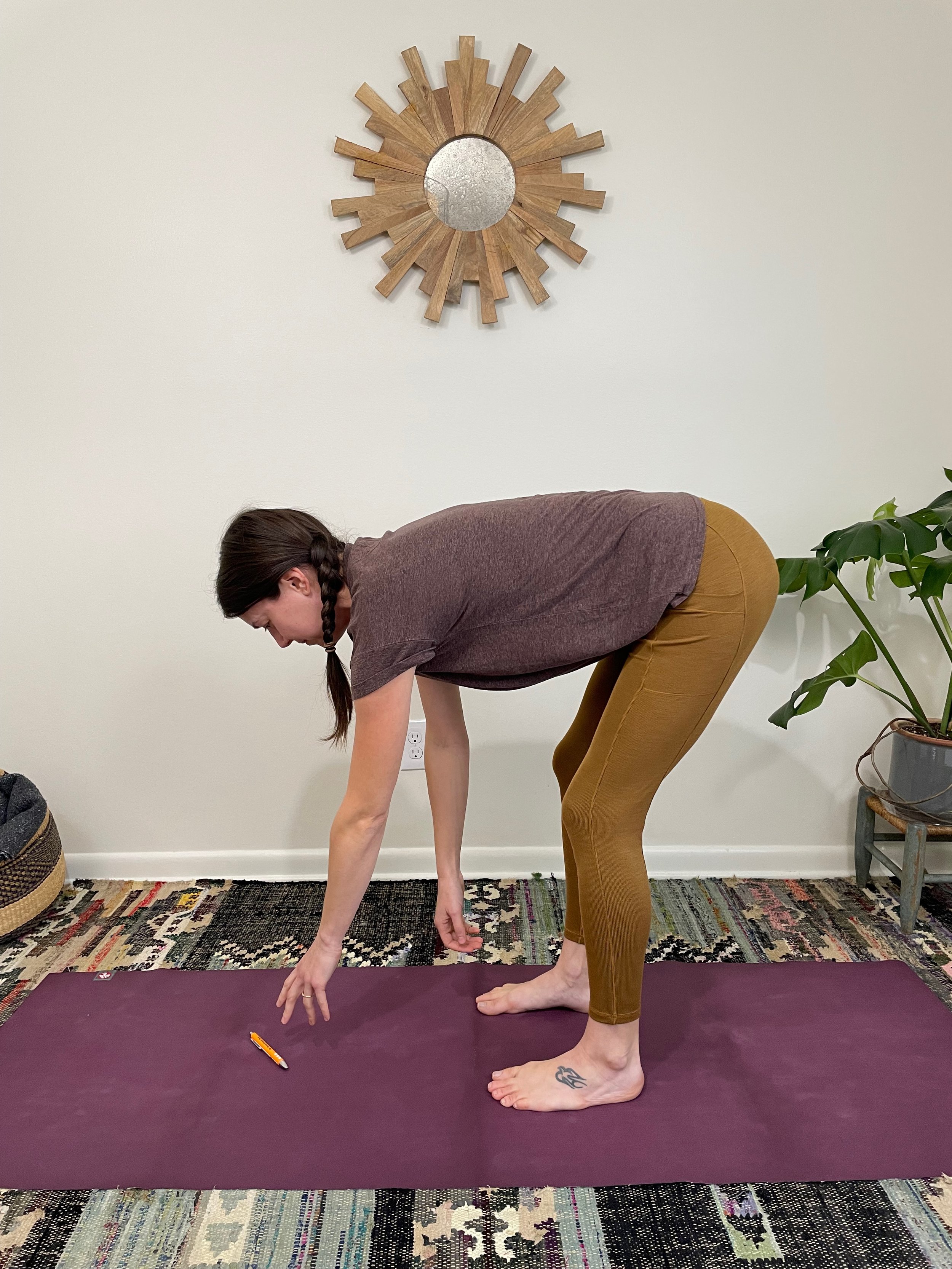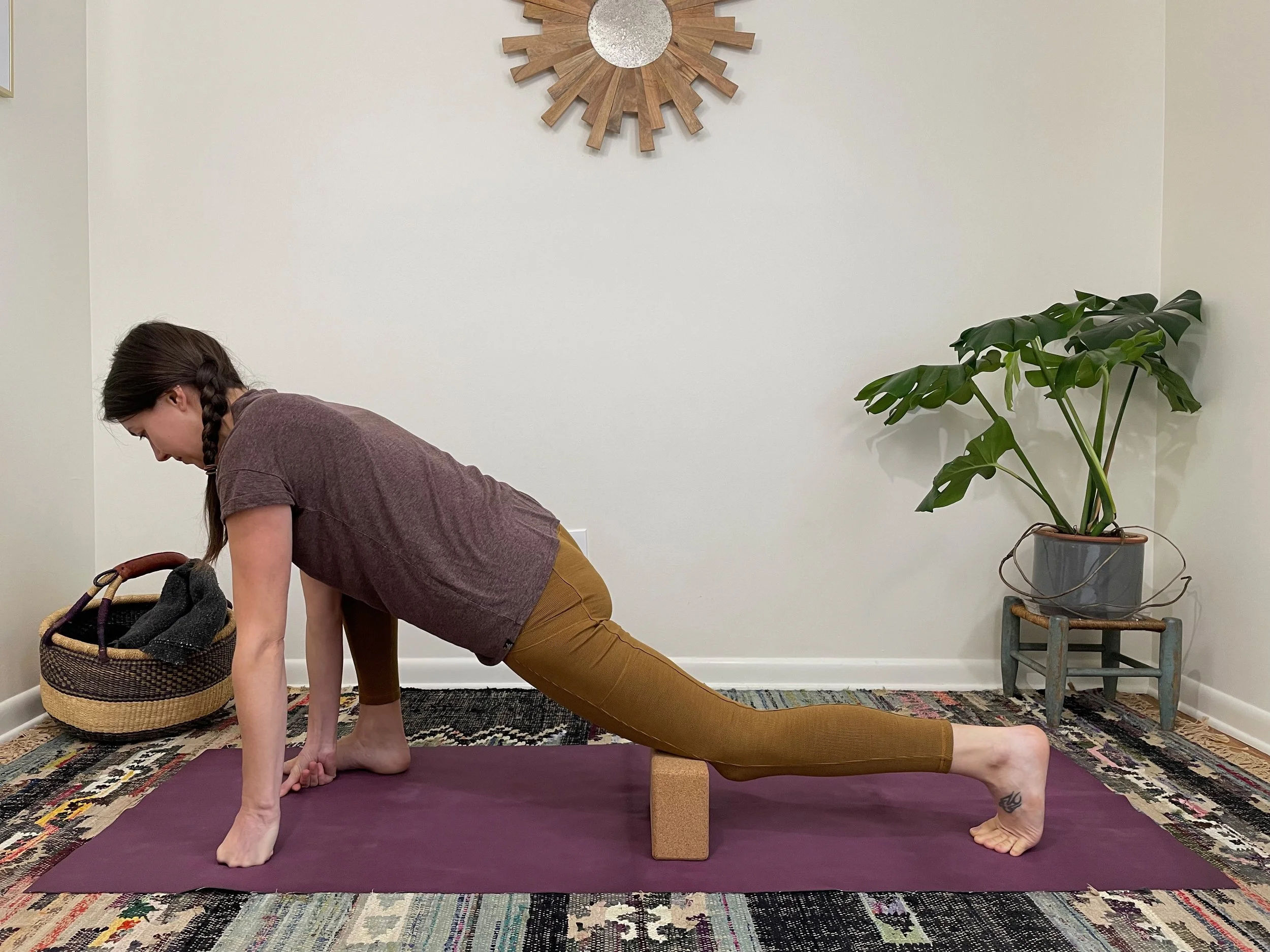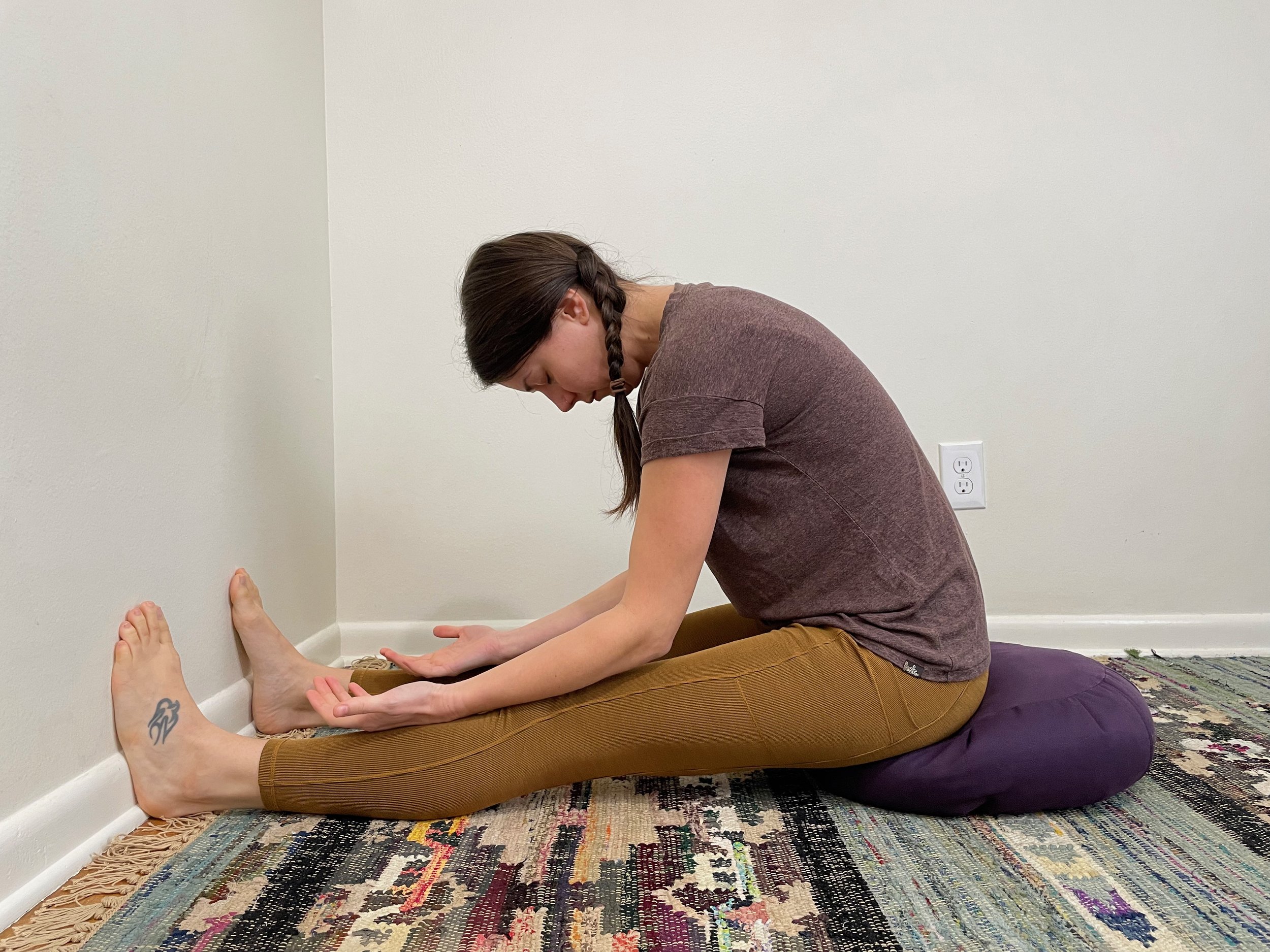Why Can't I Touch My Toes?
9 Tips for Better Bending
Sometimes I link to products I love. As an Amazon Associate, I earn a commission from qualifying purchases.
“I can touch my toes while standing but not while sitting—why not?”
This was the question my dad posed to me in a recent phone call.
For the past few years, he’s been following along with some exercises I shared with him to promote mobility and healthy joints as he navigates his eighth decade on Earth. As you can imagine, I was super excited to nerd out and answer his question!
The Back Line
Here’s what I told my dad:
Imagine that all the muscles on the back side of your body are connected, almost like one big muscle: from the soles of your feet, to your calves and hamstrings, to your glutes, the muscles up your back, to the back of your neck, and even up over the top of your head to your eyebrows. This is your “back line” and it’s made up of the train of muscles from the soles of your feet to the tops of your eyebrows.
Your “back line” is comprised of the muscles from the soles of your feet to the tops of your eyebrows, as represented by the yoga strap. ©KindBody Movement, LLC
Slack Line
Certain movements and body positions tug at or slacken this back line of muscle. For example, when you sit in a chair, lift your heels, or bend your knees, the back line of muscle gets some slack in it.
When you reach down and try to touch your toes, you take some of that slack out. Other things like the position of your pelvis and the angle of your neck can also affect the amount of slack in your back line.
I know that my dad frequently wears shoes in the house and that his gym shoes have about a one-inch heel height. Was he wearing these shoes during his standing stretch?
Yup.
That one-inch of heel on his gym shoes gave some slack to his back line, making it seem easier to touch his toes while standing. While seated, however, that slack was gone and it felt more difficult for my dad to reach his toes.
See the slack that develops in the back line when I elevate my heel? ©KindBody Movement, LLC
My dad’s next question, of course, was…
“So, how can I touch my toes?”
As a former yoga teacher, I’ve heard this questions more times than I can count. Unfortunately, I don’t have a magic potion or movement formula to get you there.
Your central nervous system (CNS) is working like crazy behind the scenes to manage risk and keep you safe. If your CNS doesn’t think it’s “safe” for you to touch your toes, it will put up a roadblock (stretch sensation) to prevent you from leaving the “safe zone.”
Perhaps your CNS is checking you because there’s not enough slack or strength (or a combination of both) to allow your body to get into that geometry.
Speaking of geometry, let’s consider the geometry our bodies experience frequently: chair sitting shape.
What happens to my body when I sit in a chair?
Let’s return to the concept of the back line—where we imagine the muscles on the backside of the body (from soles to head) are all connected as one long muscle.
When the body is in the chair shape position, there’s all kinds of slack in that back line of muscles, especially from the waist down. That looks like feet on the ground (maybe in heels), knees bent, and possibly a tucked under pelvis.
If you’re sitting most of the time, the back line of your lower half is logging a lot of hours in an incredibly shortened position.
As a result, touching your toes becomes an infrequent body geometry and your CNS can read that as risky and unsafe.
“If my body won’t let me touch my toes because it thinks it’s unsafe—why should I even want to touch my toes?”
For some reason, being able to touch your toes has become the hallmark of flexibility. But is it super important?
Forward folds and bends can certainly give your back a nice stretch and can help with “off-the-mat” movements. But they can also be unhelpful for some folks in that they increase feelings of pain or discomfort as opposed to alleviating it.
The combo of flexibility and strength in my back line allows me to forward bend to pick up a pen I dropped on the ground. ©KindBody Movement, LLC
Why You Can’t Touch Your Toes
Other factors holding you back from touching your toes could be out of your control entirely, like the length of your torso and arms relative to your legs. (Now imagine a T-Rex trying to touch its toes.) Factors such as spinal mobility, hip mobility, and body fat are also at play.
Remember that stretch sensation (whether it’s a feeling of pain or a yummy stretch) comes from your nervous system. Some folks really enjoy the stretch of a forward bend while others don’t. Folks who experience a severe and uncomfortable stretch sensation may simply have a CNS that deems the movement more unpalatable than others.
Paying close attention to the quality of the sensations you feel can help you tease out which movements may be more helpful than others. Never push too hard in a stretch—it can actually be counterproductive.
Daily Bends
Whether or not you can reach your toes, forward bending movements can help you feel more free and strong in your body. When I talk about forward bending movements, I’m referring generally to activities that create the body geometry of bringing the front of the torso toward the front of the legs.
Off-the-Mat Forward Bending Movements:
Putting on or tying shoes
Picking something up from the ground
Weeding in the garden
Loading/unloading the dishwasher
Plugging in the vacuum cleaner
Consider also that the movement out of or away from these body geometries (unbending) requires strength and mobility as well.
If you still really want to touch your toes OR you just want to feel more freedom and strength in forward bends, try these 4 lifehacks and 5 exercises to lengthen your back line.
Life Hacks for Better Bending
01. Ditch the heels.
Heeled shoes don’t allow your feet and ankles to move as much. If you really want to reach your feet, spend more time barefoot.
02. Sit on your sit bones—not behind them.
Untuck your pelvis and find neutral.
03. You Oughta Get an Ottoman
If you must sit in a chair for long periods of time, keep an ottoman under your desk (or even a folding step stool like this one) and prop your feet on it for parts of the day. Straightening the knees brings more length to the backs of the legs.
04. Don’t Just Sit There
Diversify your workstation so you can rotate through a variety of body geometries throughout the day (standing desk, stability ball, floor seat).
Exercises for Better Bending
01. Roll out your feet.
Use a tennis ball or a massage ball like this one to give yourself a foot massage. You can either roll your foot on the ball or step on and off it to compress and release. Either way, allow your foot to “drape” over the ball to mobilize the smaller joints in the foot.
02. Calf Stretch
You can use a half dome or a rolled blanket for the calf stretch form. Step the ball of your foot on the dome and check in. If you feel a good stretch sensation, stay put. If you want to increase the stretch sensation, gradually step your other foot forward.
03. Double Calf Stretch
Stand with your feet hip bone distance apart, facing a chair. Tip your pelvis forward until your hands rest on the chair (if they don’t reach, add a stack of books, blankets, pillows, or yoga blocks—you could also try using a kitchen counter or your desk). Relax your spine toward the ground and allow your tailbone to rise toward the ceiling.
04. Block Lunge
Come into a low lunge position. If you’re hands don’t comfortably reach the ground, place them on blocks, step stools, or sturdy stacks of books. Place another block under your back leg and lower the leg down to rest on the block. The block should sit just above the knee cap, on the fleshy part of the thigh. In this picture, my block is on the medium setting but you can feel free to place yours on a lower or higher setting. Hang out and breathe for 60-90 secs.
05. Soles Against the Wall
Sit with the soles of your feet against the wall. Elevate your hips until you can comfortably straighten your knees. Relax your torso toward your thighs and then relax your head/neck. Don’t force it, just soften into it. Hang out here, breathing deeply, calming your mind, for 30-90 seconds.
The Bottom Line for Your Back Line
Whether or not you can touch your toes, having a mobile and functional back line is important for daily “off-the-mat” activities. These life hacks and exercises will help you fold and bend with greater ease.
How close can you get to your toes? Does your range of motion seem to be working for you? Do you feel like tight hamstrings are holding you back from easily accomplishing everyday movements?













